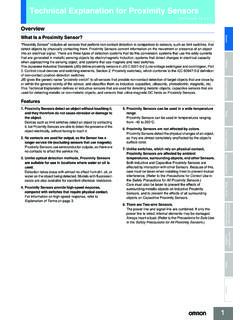Transcription of CHAPTER 3: SENSORS - Analog Devices
1 CHAPTER 3: SENSORS . SECTION : POSITIONAL SENSORS LINEAR VARIABLE DIFFERENTIAL TRANSFORMERS (LVDT) HALL EFFECT MAGNETIC SENSORS RESOLVERS AND SYNCHROS INDUCTOSYNS ACCELEROMETERS iMEMS ANGULAR-RATE-SENSING GYROSCOPE GYROSCOPE DESCRIPTION CORIOLIS ACCELEROMETERS MOTION IN 2 DIMENSIONS CAPACITIVE SENSINGS IMMUNITY TO SHOCK AND VIBRATION REFERENCES SECTION : TEMPERATURE SENSORS INTRODUCTION SEMICONDUCTOR TEMPERATURE SENSORS CURRENT OUT TEMPERATURE SENSORS CURRENT AND VOLTAGE OUTPUT TEMPERATURE SENSORS THERMOCOUPLE PRINCIPLES AND COLD-JUNCTION. COMPENSATION AUTO-ZERO AMPLIFIER FOR THERMOCOUPLE. MEASUREMENTS RESISTANCE TEMPERATURE DETECTORS (RTDs) THERMISTORS DIGITAL OUTPUT TEMPERATURE SENSORS THERMOSTATIC SWITCHES AND SET-POINT CONTROLLERS MICROPROCESSOR TEMPERATURE MONITORING REFERENCES SECTION : CHARGE COUPLED Devices (CCDs) REFERENCES SECTION : BRIDGE CIRCUITS INTRODUCTION AMPLIFING AND LINEARIZING BRIDGE OUTPUTS 3,75.
2 DRIVING REMOTE BRIDGES SYSTEM OFFSET MINIMIZATION REFERENCES SECTION : STRAIN, FORCE, PRESSURE. AND FLOW MEASUREMENTS STRAIN GAGES BASIC LINEAR DESIGN. SECTION : STRAIN, FORCE, PRESSURE. AND FLOW MEASUREMENTS (CONT). SEMICONDUCTOR STRAIN GAGES BRIDGE SIGNAL CONDITION CIRCUITS REFERENCES SENSORS . POSITIONAL SENSORS . CHAPTER 3: SENSORS . SECTION : POSITIONAL SENSORS . Linear Variable Differential Transformers (LVDTs). The linear variable differential transformer (LVDT) is an accurate and reliable method for measuring linear distance. LVDTs find uses in modern machine-tool, robotics, avionics, and computerized manufacturing. The LVDT (see Figure ) is a position-to-electrical sensor whose output is proportional to the position of a movable magnetic core.
3 The core moves linearly inside a transformer consisting of a center primary coil and two outer secondary coils wound on a cylindrical form. The primary winding is excited with an AC voltage source (typically several kHz), inducing secondary voltages which vary with the position of the magnetic core within the assembly. The core is usually threaded in order to facilitate attachment to a nonferromagnetic rod which in turn in attached to the object whose movement or displacement is being measured. +. THREADED. CORE VA. AC. ~ VOUT = VA VB. SOURCE VB. ". _. VOUT VOUT. SCHAEVITZ. E100 _ POSITION + _ POSITION +. Figure : Linear Variable Differential Transformer (LVDT). The secondary windings are wound out of phase with each other, and when the core is centered the voltages in the two secondary windings oppose each other, and the net BASIC LINEAR DESIGN.
4 Output voltage is zero. When the core is moved off center, the voltage in the secondary toward which the core is moved increases, while the opposite voltage decreases. The result is a differential voltage output which varies linearly with the core's position. Linearity is excellent over the design range of movement, typically or better. The LVDT offers good accuracy, linearity, sensitivity, infinite resolution, as well as frictionless operation and ruggedness. A wide variety of measurement ranges are available in different LVDTs, typically from 100 m to 25 cm. Typical excitation voltages range from 1 V to 24 VRMS, with frequencies from 50 Hz to 20 kHz. Note that a true null does not occur when the core is in center position because of mismatches between the two secondary windings and leakage inductance.
5 Also, simply measuring the output voltage VOUT will not tell on which side of the null position the core resides. + ABSOLUTE. FILTER. VALUE. + VOUT. AC. ~ _. SOURCE. ABSOLUTE. _ FILTER. VALUE. LVDT. + VOUT. _ POSITION +. _. Figure : Improved LVDT Output Signal Processing A signal conditioning circuit which removes these difficulties is shown in Figure where the absolute values of the two output voltages are subtracted. Using this technique, both positive and negative variations about the center position can be measured. While a diode/capacitor-type rectifier could be used as the absolute value circuit, the precision rectifier shown in Figure is more accurate and linear. The input is applied to a V/I. converter which in turn drives an Analog multiplier.
6 The sign of the differential input is SENSORS . POSITIONAL SENSORS . detected by the comparator whose output switches the sign of the V/I output via the Analog multiplier. The final output is a precision replica of the absolute value of the input. These circuits are well understood by IC designers and are easy to implement on modern bipolar processes. gm STAGE. + MULTIPLIER. INPUT. V/I OUTPUT. _. +. 1. _. COMPARATOR. Figure : Precision Absolute Value Circuit (Full Wave Rectifier). The industry-standard AD598 LVDT signal conditioner shown in Figure (simplified form) performs all required LVDT signal processing. The on-chip excitation frequency oscillator can be set from 20 Hz to 20 kHz with a single external capacitor. Two absolute value circuits followed by two filters are used to detect the amplitude of the A and B.
7 Channel inputs. Analog circuits are then used to generate the ratiometric function [A B]/[A + B]. Note that this function is independent of the amplitude of the primary winding excitation voltage, assuming the sum of the LVDT output voltage amplitudes remains constant over the operating range. This is usually the case for most LVDTs, but the user should always check with the manufacturer if it is not specified on the LVDT. data sheet. Note also that this approach requires the use of a 5-wire LVDT. A single external resistor sets the AD598 excitation voltage from approximately 1 VRMS. to 24 VRMS. Drive capability is 30 mARMS. The AD598 can drive an LVDT at the end of 300 feet of cable, since the circuit is not affected by phase shifts or absolute signal magnitudes.
8 The position output range of VOUT is 11 V for a 6 mA load and it can drive up to 1000 feet of cable. The VA and VB inputs can be as low as 100 mV RMS. The AD698 LVDT signal conditioner (see Figure ) has similar specifications as the AD598 but processes the signals slightly differently and uses synchronous demodulation. The A and B signal processors each consist of an absolute value function and a filter. The A output is then divided by the B output to produce a final output which is ratiometric and independent of the excitation voltage amplitude. Note that the sum of the LVDT. secondary voltages does not have to remain constant in the AD698. BASIC LINEAR DESIGN. AD598. EXCITATION AMP ~. OSCILLATOR. VA ABS. + FILTER. VALUE.
9 A B VOUT. FILTER AMP. A+B. ABS. _ FILTER. VALUE. VB. 5-WIRE LVDT. Figure : AD598 LVDT Signal Conditioner (Simplified). AD698. EXCITATION AMP ~ REFERENCE. OSCILLATOR. VB B. +. A VOUT. FILTER AMP. B. VA A. A, B = ABSOLUTE VALUE + FILTER. _. 4-WIRE LVDT. Figure : AD698 LVDT Signal Conditioner (Simplified). The AD698 can also be used with a half-bridge (similar to an auto-transformer) LVDT as shown in Figure In this arrangement, the entire secondary voltage is applied to the B. processor, while the center-tap voltage is applied to the A processor. The half-bridge LVDT does not produce a null voltage, and the A/B ratio represents the range-of-travel of the core. SENSORS . POSITIONAL SENSORS . AD698. EXCITATION AMP ~ REFERENCE.
10 OSCILLATOR. +. B. A VOUT. FILTER AMP. B. A. _. A, B = ABSOLUTE VALUE + FILTER. HALF BRIDGE LVDT. Figure : Half-Bridge LVDT Configuration It should be noted that the LVDT concept can be implemented in rotary form, in which case the device is called a rotary variable differential transformer (RVDT). The shaft is equivalent to the core in an LVDT, and the transformer windings are wound on the stationary part of the assembly. However, the RVDT is linear over a relatively narrow range of rotation and is not capable of measuring a full 360 rotation. Although capable of continuous rotation, typical RVDTs are linear over a range of about 40 about the null position (0 ). Typical sensitivity is 2 to 3mV per volt per degree of rotation, with input voltages in the range of 3 VRMS at frequencies between 400 Hz and 20 kHz.


















